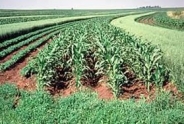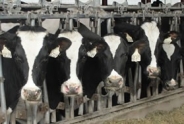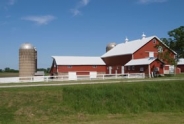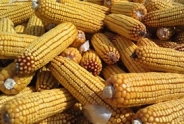All Things Tillage
Katelyn Miller, Field Crops and Forage Specialist
Southwest New York Dairy, Livestock and Field Crops Program

While making farm visits this winter, I asked producers what field crop information they were looking for. Tillage was the topic that was repeatedly brought up. What does the transition to no-till look like? What are the benefits and challenges with conventional tillage systems and no-till systems? Should I be completing tillage in the fall or spring? How can we make tillage more efficient?
These are some of the frequently asked questions I have received about tillage, but the answer often varies. Every management decision that gets made will have tradeoffs. Understanding tradeoffs and available resources will help guide you to the best tillage management system.
What is tillage?
Tillage is the mechanical manipulation of the soil into a desired condition with a purpose. The purpose of tillage may look different for everyone. These purposes could include managing residue, incorporating amendments like manure and lime, preparing the seedbed for planting, as temporary relief from compaction and rutting, and weed control.
Should I perform tillage in the spring or fall?
Fall tillage is best adapted to heavy clay soils with a high-water holding capacity. Soil profiles are usually drier in the fall. As a result, the soil is less likely to smear. A large consideration in this decision is labor. Fall tillage is often completed after the harvest of corn silage and before grain corn is taken off. While there is not a time of year that is not busy, there are less time constraints in the fall than in the spring. Also, the soil is more likely to erode throughout the winter.
Wet spring conditions make tillage a difficult task to achieve. Unlike fall tillage, there is more of a time constraint to complete tillage in the spring. Additionally, spring tillage leaves the soil surface more prone to crusting. With spring tillage, the soil will be exposed for a shorter period, decreasing the erosion potential. One of the biggest benefits of spring tillage is it will create an excellent seedbed to plant into.
What are the benefits and challenges with conventional tillage systems and no-till systems?
In conventional tillage systems, tillage can be used to temporarily improve soil conditions. Tillage helps prepare the seedbed, aerate the soil, and decreases soil resistance. It is an effective way to incorporate soil amendments (lime, fertilizer, manure) and helps warm the soil faster. Tillage is also a valuable method of weed control. While this system has its benefits, we also must think of the challenges. One of the most notable downsides is the cost. The labor, fuel, and machinery costs are immense. Soil moisture can be tough to manage also. Soil that is too wet cannot be worked, while soil that is too dry reduces crop germination. Frequent tillage can result in soil compaction and increased erosion.
The most notable benefit to no-till is the savings in time, labor, fuel costs, and machinery. No-till systems can help reduce erosion and preserve soil moisture during droughty years. A downfall is higher pest pressure because of increased residue. With the loss of tillage as a control tool, different measures need to be taken to keep pests under control. Additionally, water does not shed from the soil as it might in a tillage system, so the soil can be too wet in the spring. Also, no-till systems can cause delayed crop development.
What does the transition to no-till look like?
There is not a written plan on the right way to transition to no-till. This process looks different in every field. Under traditional tillage systems, transitioning to no-till usually does not happen overnight. To get an accurate portrayal of no-till, a plan needs to be in place to facilitate that process. If you're interested in no-till, think about how the benefits and drawbacks fit your operation. Work with a crop consultant, Extension staff, or gain advice from farm neighbors.
How can we make tillage more efficient?
Efficiency looks different in every operation. When making management decisions about tillage, many factors should be considered. This can include, but is not limited to soil type, slope, crop rotation, time and labor availability, equipment, and your farm goals. There is not one tillage system that will suit every field on your farm.
It's important to remember that every management decision has tradeoffs. Consider your available resources to determine what may work best for your operation. Regardless of the tillage system, timeliness is key to a successful crop. Gain an understanding of when you can and cannot be in your field. Nothing is in black and white, so instead of searching for the "right" thing to do, focus on what works for you!
If you have questions about tillage, contact Katelyn Miller at 716-640-2047 or km753@cornell.edu.
Upcoming Events
Memoir Reading: Barn Gothic
December 4, 2025
Bath, NY
Barn Gothic is an elegy for family farmers and an intimate portrait of three generations laboring to be fathers and sons while their livelihood falls apart. Beautifully told with a farmer's restraint and a poet's grace, it is a story of personal loss amid corporate corruption and of finding a way forward when everything you know disappears.
NY Small Farms Summit 2025: Stronger Together
December 5, 2025
Alfred, NY
We hope you will join us on December 5th for the 2025 New York Small Farms Summit! This is an opportunity to meet other farmers and ag supporters, learn about research and education projects, and set priorities for future efforts to grow small farm success.
At the Allegany County site, we will focus on giving trees a chance and how trees build resiliency on small farms. Whether attracted to fruit, nuts, vegetables, fodder or shade, trees can be an integral part of a successful farming system. Join us as we explore the opportunities for resiliency that come from adding tree crops or managing wooded areas of your farm for agroforestry or silvopasture systems.
Crops, Cows & Critters - Southwest New York Dairy, Livestock & Field Crops Newsletter Sponsorship
December 19, 2025
Our two forms of publications feature research-based and timely information from our four specialists, listed to the right, along with local event notifications and Cornell University outreach. This information is provided to participants who range from dairy, livestock, and field crops producers to agricultural suppliers and consultants.
Weekly Email Update: Shared with 625+ households who have signed up with our program.
Monthly Paper Mailer: To reach our stakeholders and farmers who lack internet access, we send out a monthly mailer where your company's logo and contact information would be featured with a mailing list of 330+ households.
If you sponsor our weekly and monthly publications you reach approximately 955 households.
Visit our website to view our newsletters!
Announcements
No announcements at this time.





